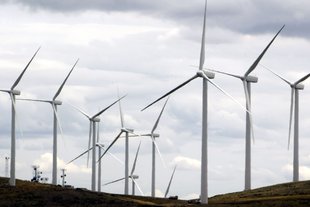forum
library
tutorial
contact

Wind Boom's Costs
Looming on the Horizon
by Editorial BoardRecord Searchlight, May 1, 2011
|
the film forum library tutorial contact |

|
Wind Boom's Costs
by Editorial Board |
 After several years of drought, the abundant rains this winter and spring have supplied a bit of relief to electric customers in Redding, whose rates have risen partly because of a shortage of cheap hydroelectricity from the Central Valley Project.
After several years of drought, the abundant rains this winter and spring have supplied a bit of relief to electric customers in Redding, whose rates have risen partly because of a shortage of cheap hydroelectricity from the Central Valley Project.
For our neighbors in the Pacific Northwest, however, the same abundance is too much of a good thing. A wet-year surplus of hydropower -- combined with recent years' boom in wind turbines -- is pushing the Bonneville Power Administration's grid beyond its limit, leaving it potentially unable even to give power away.
And even as government promotes wind farms as a source of renewable power, the BPA is considering emergency orders to shut down wind turbines, with their erratic and unpredictable generation, to avoid overwhelming the power grid. Just when the wind gets blowing, their owners might have to unplug the turbines.
Under a law Gov. Jerry Brown signed last month, California has committed to producing one-third of its power from renewable sources, including wind, within the next decade. Indeed, Brown said he's setting his sights on 40 percent renewables. That means this feast-famine cycle starting to cramp the Northwest's power grid could soon spread to California.
And one major solution? New transmission lines linking the Pacific Northwest with California's major cities and demand for renewable power, creating a more flexible West Coast power grid. Any guesses where those power lines would most likely travel? Like the scrapped TANC Transmission Projection power line, they'd probably cross right through Shasta County. At least, that's where the utilities would try to build them.
In a sense, this is a fine problem to have -- at least for supporters of clean energy. Within the past five years alone, wind developers within the Bonneville Power Administration's grid, roughly following the Columbia River Gorge, have built enough new turbines to generate more than 3,000 megawatts of electricity when they're spinning at full speed. All told, the more than 3,500 megawatts of peak wind electricity in the BPA is equivalent to five times the power output of Shasta Dam. And that doesn't include other wind farms around the Northwest or many new projects in the works. They include Big Horn Wind Farm in southern Washington, which sells electricity to Redding Electric Utility.
That's a dramatic achievement. But the problem with all that wind power is that its output floats up and down like a kite on a spring breeze. Even in the steadily windy areas that make the ideal sites for wind farms, strong gusts can ramp up power and then stop cold -- whereas our homes, factories and computer server farms demand an even supply.
It's possible to balance erratic supplies with demand to a point, by shutting down plants elsewhere. Indeed, temporarily burning less coal or natural gas stretches fuel supplies while cutting pollution, but eventually the power managers run out of fossil-fuel plants to shut down.
And regulations aimed at preserving fisheries don't allow hydroelectric dam managers to flip rivers on and off like a light switch, as needed. Indeed, much like the Sacramento River, the Columbia River with its massive series of hydroelectric dams is tightly regulated to prevent the extinction of salmon. Under current operating rules those dams can't even legally spill excess water, but are required to spin their turbines even when they don't need the power. (Heavy spills can leave too much nitrogen in the water, harming fish.)
The upshot: Massive investments in wind power don't end the need for existing electric plants, but instead force costly juggling -- and raise the pressure for even more costly new transmission lines. And when the wind really gets blowing, we might not even be able to harvest watts from it.
Using more renewable energy remains an important goal, but in the Northwest they're learning that achieving it won't be cheap or easy. As California ramps up its renewables over the next decade, those costs will be harder to ignore.
Related Pages:
Hydro, Wind Battling for Grid Space by Christine Pratt, Wenatchee World, 4/26/11
Power Peak Could Mean Lowered Income for PUDs by Christine Pratt, Wenatchee World, 4/25/11
PSE's Lower Snake River Wind Project to Boost Power Generation by Cameron Chai, Clean Tech, 4/15/11
Bonneville Power may Shut Down Wind Turbines to Protect Salmon by John Laumer, Treehugger, 4/14/11
Grid Problems Trigger Rolling Wind-Farm Outages in Pacific NW by William Pentland, Forbes, 4/14/11
Wind Turbines Shutdown Possible by David Mance, KAPP TV, 4/13/11
Wind-Power Producers Fight Possible Shutdown of Turbines by Hal Bernton, The Spokesman-Review, 4/10/11
Bonneville Power Plan Creates Buzz in Industry by Bert Caldwell, The Spokesman-Review, 4/10/11
learn more on topics covered in the film
see the video
read the script
learn the songs
discussion forum
